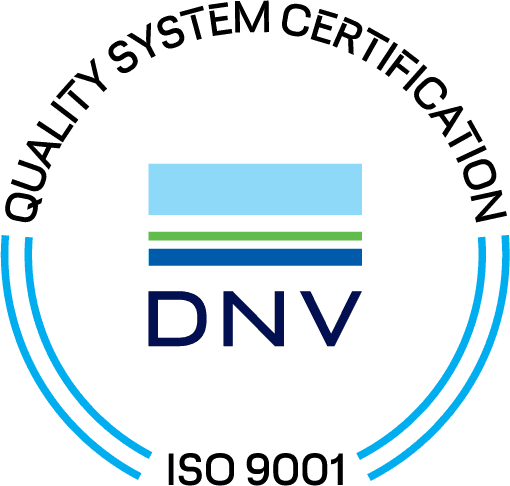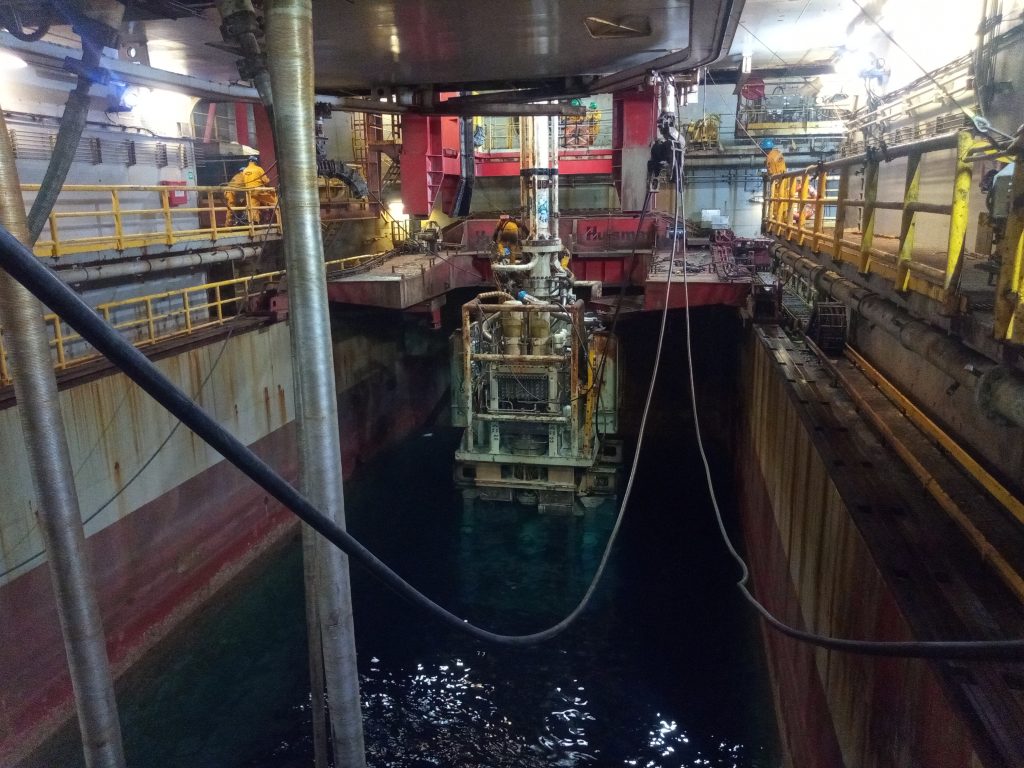
The US Department of the Interior (DoI) and Bureau of Transportation Statistics (BTS) provide information on BOP and well control equipment failures that have occurred onboard drilling rig operations in the US Gulf of Mexico (GOM) Outer Continental Shelf (OCS) area. The information analysed was derived from industry reports in the SafeOCS system.
During the period 2017–2021, a 5-year study of unsuccessful BOP runs related to deepwater drilling activities demonstrated that the industry reported an average success rate of 82.2% based on reported data.
An ADC Example:
A review of ADC Energy BOP acceptance data, where ADC BOP and WCE Specialists were onboard a 7th generational Ultra Deepwater Drillship to monitor and witness BOP pre-deployment and initial BOP testing over the last 3-year period, showed a success rate of 86.6%. This increase in the success of testing demonstrates the advantage of an independent and collaborative approach to ensure recommended practises and industry standards are adhered to during critical phases of drilling unit operations.
This directly resulted in reduced overall rig downtime and any associated costs.
During the period 2018–2022, ADC Energy BOP and WCE specialists conducted various levels of inspection and verification workscopes on floating drilling units, subsea BOP and well control systems worldwide.
The ADC inspections were conducted on all major BOP system types and included both shallow water and ultra deepwater systems.
At our clients request, ADC Energy remained onboard the drilling unit following acceptance, End of Well (EOW) or Between Well Maintenance (BWM) periods to verify pre-deployment testing and initial testing.
The ADC Energy BOP & Well Control team collated this information to determine the advantage of having an ADC BOP specialist onboard the drilling unit during BOP inspection, pre-deployment, and initial testing and also to recognise and report on observed common causes of BOP run failures, providing clients and regulatory bodies with key areas of concern or areas where lessons can be learned and improvements developed for future BOP runs.
There were, however, occasions where ADC Energy conducted the acceptance inspection / EOW / BWM but did not witness the actual pre-deployment testing, BOP run, or subsequent initial testing on the well. These inspection statistics have not been utilised for this report.
Only statistics verified by ADC Energy are used to determine the success or failure of the BOP run and where rig downtime was required to rectify issues resulting from unsuccessful BOP runs.
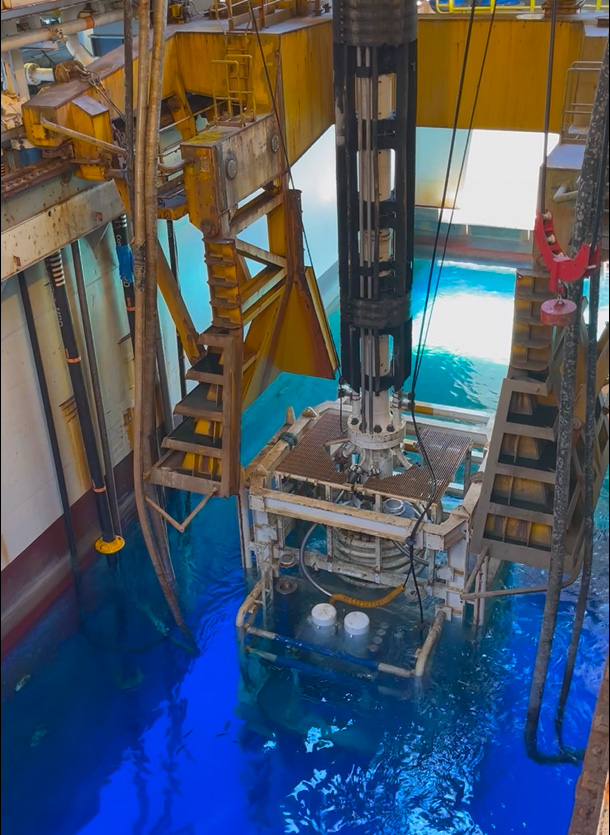
API S 53, Well Control Equipment Systems for Drilling Wells, 5th Edition, 2018
(Click Here to Learn More)
Pre-Deployment Testing
Initial Testing
Most issues observed with BOPs can be identified during pre-deployment testing while the BOP stack is safely on the surface. It cannot, however, be guaranteed that the status of the BOP will be maintained following deployment, first after structural lift, transit through the splash zone, and deployment to the various operational depths where sub-surface currents and surface meteorological conditions, decreasing temperatures, and increasing hydrostatic pressures can affect the operational stability and integrity of the BOP stack. Additionally, the operation of the wellhead connectors and condition of the wellhead gasket, through impact upon landing the BOP on the wellhead or debris on the gasket or wellhead connector interfaces cannot be discounted from such remote operations.
This is why successful completion of the initial subsea testing must be carried out prior to operations commencing.
The US Department of the Interior (DoI) and Bureau of Transportation Statistics (BTS) provide information on BOP and well control equipment failures that have occurred in the course of drilling rig operations in the US Gulf of Mexico (GOM) Outer Continental Shelf (OCS) area.
The information analysed was derived from industry reports in the SafeOCS system. SafeOCS is a confidential reporting system that collects and analyses data to advance safety in oil and gas operations in the OCS and was developed jointly between the DoI Bureau of Safety and Environmental Enforcement (BSEE) and the Department of Transportation’s Bureau of Transportation Statistics (BTS).
The SafeOCS 5-Year review contains an analysis of the reported issues as a whole, including faults that result in unplanned or unscheduled BOP pulls from operational wells.
Key issues identified through the review of the 5-year period:
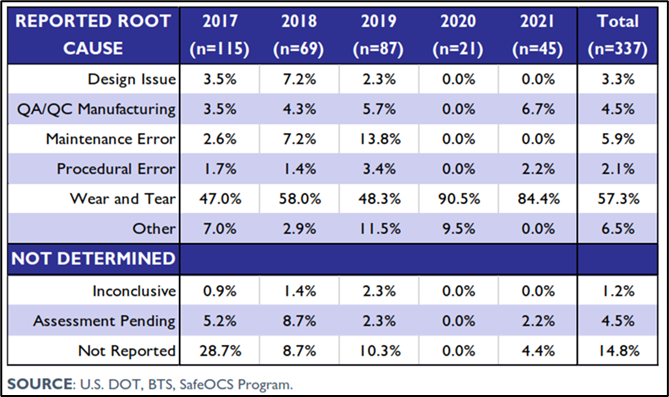
In addition to the root causes in the extract above, the BTS / SafeOCS Well Control Equipment Systems Safety 2022 Annual Report details the common failures by subunit (system) and component that have been reported during the last 2 phases of BOP testing: Pre-Deployment and Initial Testing. Key systems prone to failure during the BOP run, as statistically shown and which do not come as a surprise through ADC Energy experience, include BOP controls (conventional hydraulic and MUX).
It should be emphasised that, in the majority of cases, the BOP stack would require retrieval when the control system event occurred.
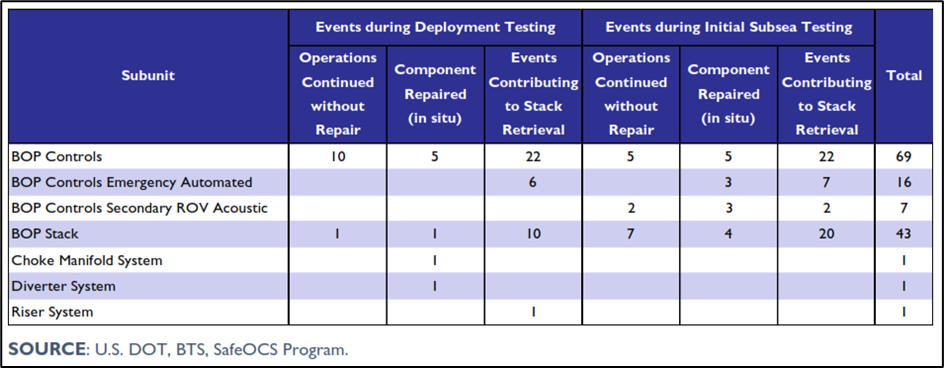
When reviewing the component level failure review, the results, once again, are not unexpected and are regularly observed, particularly when read in parallel with Table 9: Root Causes of Subsea Events, and in most cases can be mitigated through effective maintenance policies and procedures, quality, traceable original equipment and spares, and a competent crew.
SPM Valves are generally inspected / changed on an appropriate rotational basis to mitigate the failure mode through a preventative change policy based on known failure rates and timelines – based on operational parameters and exposure.
Electrical connectors, PBOF units, and fibre connections are also known to result in statistically proven issues during deployment. These issues can also be reduced in frequency or criticality through the same policies and procedures mentioned above, but they may also require a greater degree of OEM participation and support.
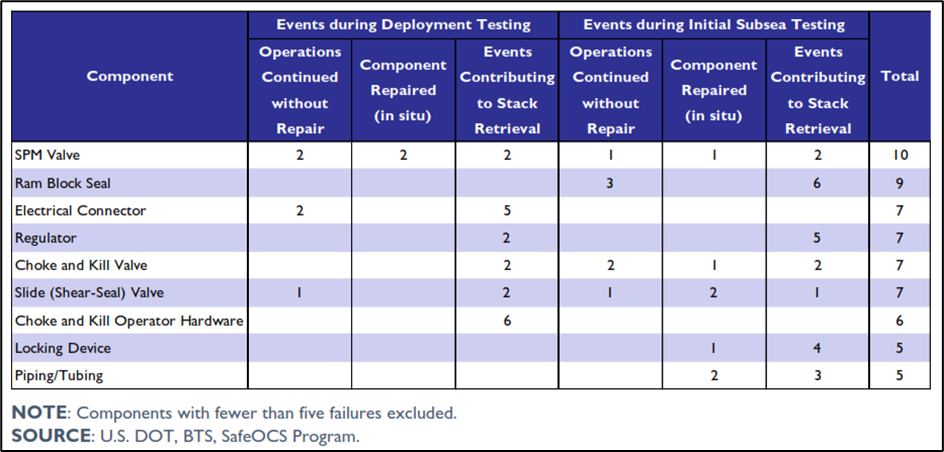
Key workscopes for all ADC Energy BOP and WCE inspections, including monitoring and witnessing pre-deployment testing, BOP deployment, and initial testing on the wellhead prove the value of utilising highly experienced and capable Subject Matter Experts (SMEs). These SMEs can review key data relevant to the planned operations, historic and current BOP maintenance routines, and provide independent qualified analysis on the design and suitability of the BOP and WCE.
Traceability of equipment and the overall condition of the systems are also vital considerations to reduce the risks of failed BOP deployments.
ADC specialists consider and review the following key focus points during each inspection period and, based on the failure statistics reported by SafeOCS, provide valuable mitigation to the most common issues and points of failure noted:
ADC Energy: 2019 to 2022
BOP runs where ADC Energy BOP Specialists have been onboard and able to witness and review maintenance procedures, monitor pre-deployment testing, and monitor the BOP run and landing the BOP on the well (including BOP Initial Testing):
Note: Successful runs include those where BOP operations have continued without issues, where issues have been identified, but through analysis of the issue and review of the BOP system and redundancy levels available or where component rectification has been carried out remotely (through the control system), the BOP has been deemed safe and operational to continue.
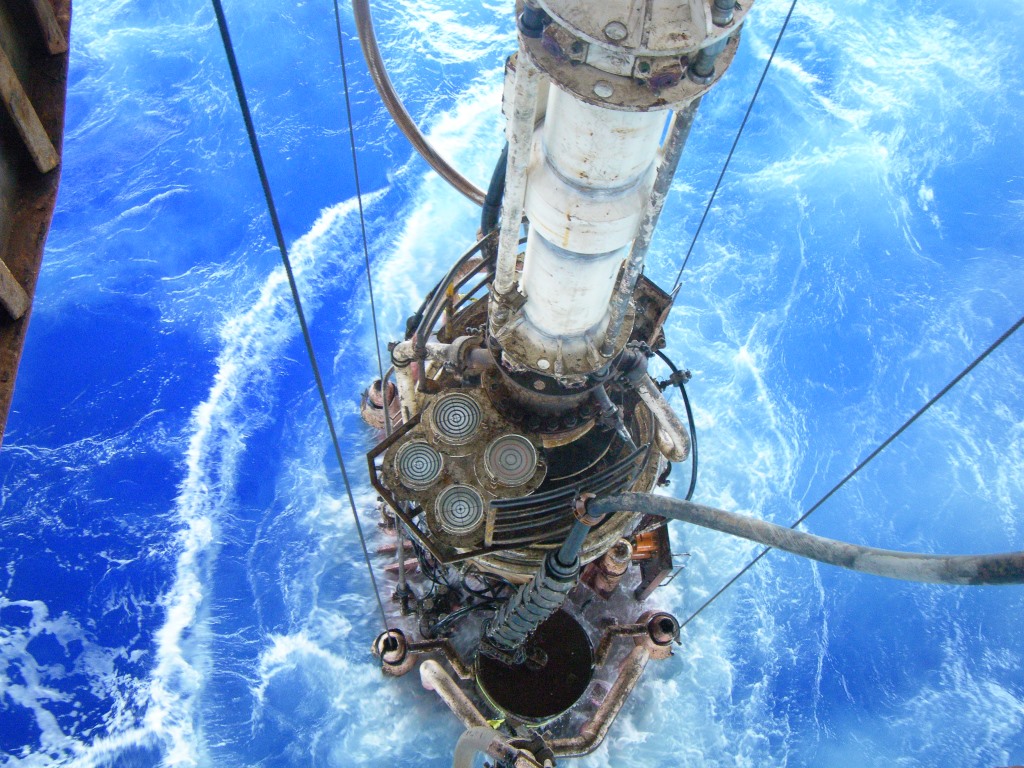
Failed runs were classified as those where issues were witnessed and the status of the BOP stack and control system, following troubleshooting and diagnostic discussions, required the retrieval of the BOP stack to surface for repairs or further troubleshooting.
Although the sample size being considered was somewhat smaller than SafeOCS, this translates to a success rate of 87.5% for each BOP deployment operation where ADC Energy has been involved in the witnessing and monitoring of BOP pre-deployment and initial BOP tests.
References:
ADC Energy TRAMS Database
DoI – SafeOCS: 2017 to 2021
The below table shows data derived from the US Department of Transportation’s BTS, Well Control Equipment Systems Safety, 2022 Annual Report:

5-Year SafeOCS Total:
References:
US Dept of Transportation – BTS, Well Control Equipment Systems Safety, 2022 Annual Report
The BTS SafeOCS Well Control Systems Safety 2022 Annual Review provides valuable information, both statistical and technical, on the issues that have been observed during BOP deployment within operations in the US GoM.
From ADC Energy’s experience conducting BOP acceptance inspections worldwide, the SafeOCS data collated over a 5-year period could reasonably be transferred to all common drilling unit geographical locations, operational conditions and environments.
The industry’s successful BOP run was reported at 82.2%.
Where ADC Energy was involved in BOP runs – data was collected and verified at an 87.5% success rate.
The issues documented as root causes and commonly observed failure modes are also known to the industry and are key areas of focus on the path to greater personal and environmental safety and operational efficiency.
In this aspect, and perhaps contrary to certain opinions, increased efficiency and a reduction in drilling unit downtime should be able to be directly associated with increased crew and environmental safety in the case of BOP safety and efficiency.
The root causes of both unplanned and planned BOP stack retrieval are generally known to be mitigated through adherence to prescriptive maintenance schedules, equipment design standards, and appropriate procedures and plans.
These mitigation aspects are key elements of ADC Energy inspection workscopes, in addition to a simple visual inspection of equipment and systems, and can be seen through the successful BOP run statistics observed to add to the operational efficiency of the BOP and drilling unit.
The benefits of a competent and independent ‘fresh set of eyes’ onboard the drilling unit at critical phases, where crews are extremely busy, can be seen to benefit both the operator and drilling unit contractor.
E: Email ADC UK
